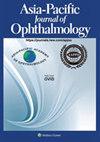病理性近视的眼底网状结构密度。
IF 3.7
3区 医学
Q1 OPHTHALMOLOGY
引用次数: 0
摘要
目的:该研究旨在应用人工智能技术,通过眼底照片定量评估不同类别病理性近视(PM)的眼底方格密度(FTD):方法:对407只病理性近视(META-PM,第2类-第4类)眼进行了回顾性研究,采用了人类视觉的生物模拟机制和综合图像处理技术来提取和计算FTD。使用两种分区方法("X "和 "+")分析了不同的感兴趣区,包括圆 O4.5(以视盘为中心,直径为 4.5 毫米)和圆 M1.0、M3.0、M6.0(以黄斑为中心,直径分别为 1.0、3.0 和 6.0 毫米)。斑块(第 3 类)或黄斑萎缩(第 4 类)区域的密度被量化。进行单变量和多变量线性回归分析,以评估与 FTD 的关联:结果:所有 PM 眼的平均 FTD 为 0.283,范围在 0.002 到 0.500 之间,与 PM 类别呈负相关。在多变量分析中发现,年龄与FTD有显著相关性(P 结论:研究显示,PM眼的FTD呈下降趋势:研究显示,无论是否存在斑块或黄斑萎缩区,不同类别的 PM 的 FTD 值均呈下降趋势。对永久性近视的FTD进行定量分析是一种有价值的工具,有助于改进现有的永久性近视分类系统,并深入了解高度近视后葡萄膜瘤和视野缺损的起源。本文章由计算机程序翻译,如有差异,请以英文原文为准。
Fundus Tessellated Density of Pathologic Myopia
Purpose:
The study aimed to quantitatively evaluate the fundus tessellated density (FTD) in different categories of pathologic myopia (PM) using fundus photographs with the application of artificial intelligence.
Methods:
A retrospective review of 407 PM (META-PM, Category 2–Category 4) eyes was conducted, employing a biomimetic mechanism of human vision and integrated image processing technologies for FTD extraction and calculation. Different regions of interest were analyzed, including circle O4.5 (optic disc centered, diameter of 4.5 mm) and circle M1.0, M3.0, M6.0 (macular centered, diameter of 1.0, 3.0, and 6.0 mm), using 2 partitioning methods (“X” and “+”). The density of patchy (Category 3) or macular atrophy (Category 4) areas was quantified. Univariate and multivariate linear regression analyses were performed to assess the association with FTD.
Results:
The mean FTD of total PM eyes was 0.283, ranging from 0.002 to 0.500, and demonstrating a negative correlation with the PM category. In multivariate analysis, age was found to be significantly associated with FTD (P<0.05), while axial length did not show a significant association. Fundus tessellation of circle O4.5 and circle M6.0 displayed associations with the FTD across different PM categories. The “X” partitioning method better fit the circle M6.0 region, while both methods were suitable for the circle O4.5 region. After excluding the patchy and macular atrophic areas, the mean FTD values were 0.346 in Category 2, 0.261 in Category 3, and 0.186 in Category 4.
Conclusions:
The study revealed a decreasing trend in FTD values across different categories of PM, regardless of the presence or absence of patchy or macular atrophic areas. Quantifying FTD in PM could be a valuable tool for improving the existing PM classification system and gaining insights into the origin of posterior staphyloma and visual field defects in high myopia.
求助全文
通过发布文献求助,成功后即可免费获取论文全文。
去求助
来源期刊

Asia-Pacific Journal of Ophthalmology
OPHTHALMOLOGY-
CiteScore
8.10
自引率
18.20%
发文量
197
审稿时长
6 weeks
期刊介绍:
The Asia-Pacific Journal of Ophthalmology, a bimonthly, peer-reviewed online scientific publication, is an official publication of the Asia-Pacific Academy of Ophthalmology (APAO), a supranational organization which is committed to research, training, learning, publication and knowledge and skill transfers in ophthalmology and visual sciences. The Asia-Pacific Journal of Ophthalmology welcomes review articles on currently hot topics, original, previously unpublished manuscripts describing clinical investigations, clinical observations and clinically relevant laboratory investigations, as well as .perspectives containing personal viewpoints on topics with broad interests. Editorials are published by invitation only. Case reports are generally not considered. The Asia-Pacific Journal of Ophthalmology covers 16 subspecialties and is freely circulated among individual members of the APAO’s member societies, which amounts to a potential readership of over 50,000.
 求助内容:
求助内容: 应助结果提醒方式:
应助结果提醒方式:


